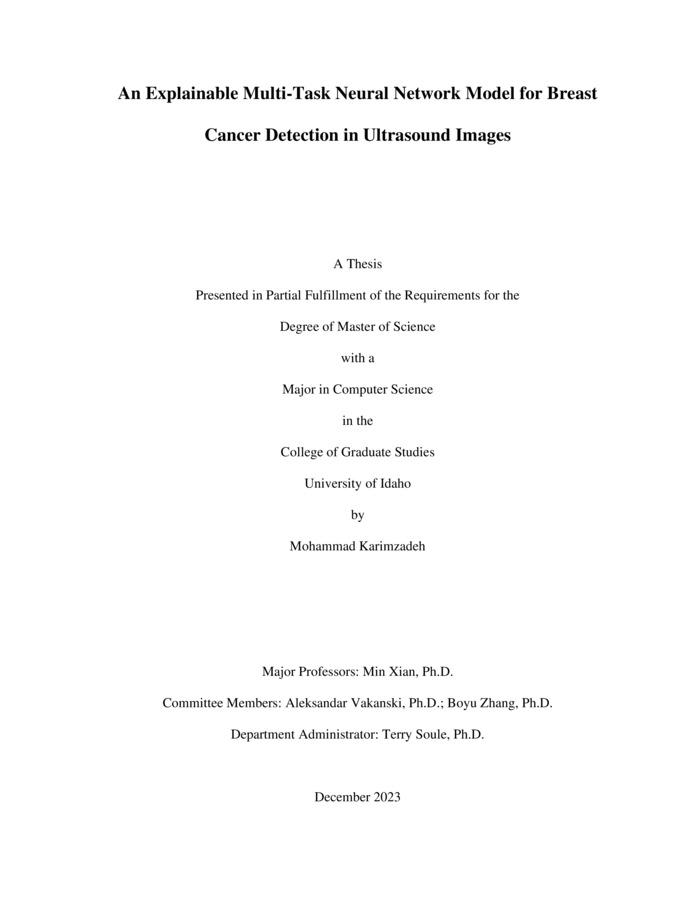An Explainable Multi-Task Neural Network Model for Breast Cancer Detection in Ultrasound Images
Karimzadeh, Mohammad. (2023-12). An Explainable Multi-Task Neural Network Model for Breast Cancer Detection in Ultrasound Images. Theses and Dissertations Collection, University of Idaho Library Digital Collections. https://www.lib.uidaho.edu/digital/etd/items/karimzadeh_idaho_0089n_12754.html
- Title:
- An Explainable Multi-Task Neural Network Model for Breast Cancer Detection in Ultrasound Images
- Author:
- Karimzadeh, Mohammad
- Date:
- 2023-12
- Program:
- Computer Science
- Subject Category:
- Computer science
- Abstract:
-
Breast cancer is one of the most common types of cancer and despite the advancements in the medical field, it still remains one of leading causes of death among women. In recent years, Breast Ultrasound (BUS) has emerged as a promising imaging modality for breast cancer diagnosis, offering high sensitivity and specificity. However, the interpretation of BUS images can be challenging and subject to human error. Computer-aided diagnosis (CAD) systems based on Machine Learning approaches have demonstrated a potential to assist radiologists in the interpretation of medical images. Nevertheless, the black-box nature of best performing CAD systems has raised concerns about their interpretability and trustworthiness. This thesis introduces MT-BI-RADS (Multi-Task BI-RADS), a novel explainable deep learning approach for breast cancer detection in BUS images. The proposed approach provides three levels of explanations for enabling radiologists to understand the decision-making process in predicting the presence of tumors in BUS images. First, the deep learning model outputs the categories of the BI-RADS lexicon that are used by radiologists for BUS image analysis and reporting. Second, the deep learning model outputs segmented regions in images that correspond to tumors. And third, the proposed approach outputs quantified contributions of each BI-RADS category toward the prediction of benign or malignant class, based on post-hoc explanation with Shapley values. By utilizing a combination of explanations at different levels of abstraction using ad-hoc and post-hoc methods, the aim is to increase the transparency of the internal mechanisms employed by the deep learning model for analysis of BUS images. Experimental validation on a large BUS dataset demonstrates that the proposed model achieved high accuracy, sensitivity, and specificity for breast cancer detection. In addition, the proposed approach achieved high-level of performance for prediction of the BI-RADS descriptors and lesion segmentation. The design of explainable AI methods for cancer detection can enhance the trustworthiness and acceptance of CAD systems by clinicians.
- Description:
- masters, M.S., Computer Science -- University of Idaho - College of Graduate Studies, 2023-12
- Major Professor:
- Xian, Min
- Committee:
- Vakanski, Aleksandar; Zhang, Boyu; Soule, Terence
- Defense Date:
- 2023-12
- Identifier:
- Karimzadeh_idaho_0089N_12754
- Type:
- Text
- Format Original:
- Format:
- application/pdf
- Rights:
- In Copyright - Educational Use Permitted. For more information, please contact University of Idaho Library Special Collections and Archives Department at libspec@uidaho.edu.
- Standardized Rights:
- http://rightsstatements.org/vocab/InC-EDU/1.0/

